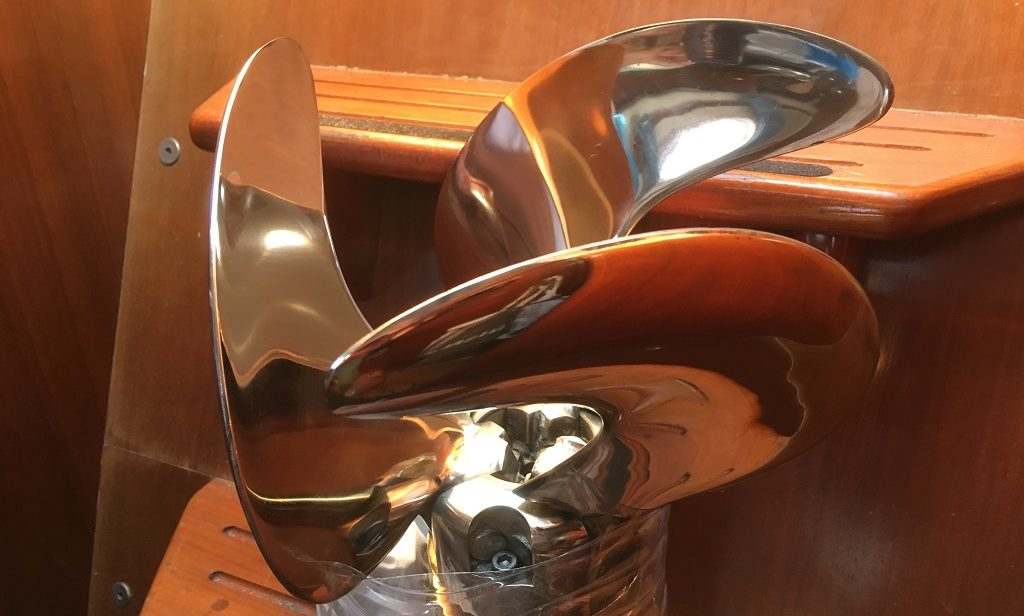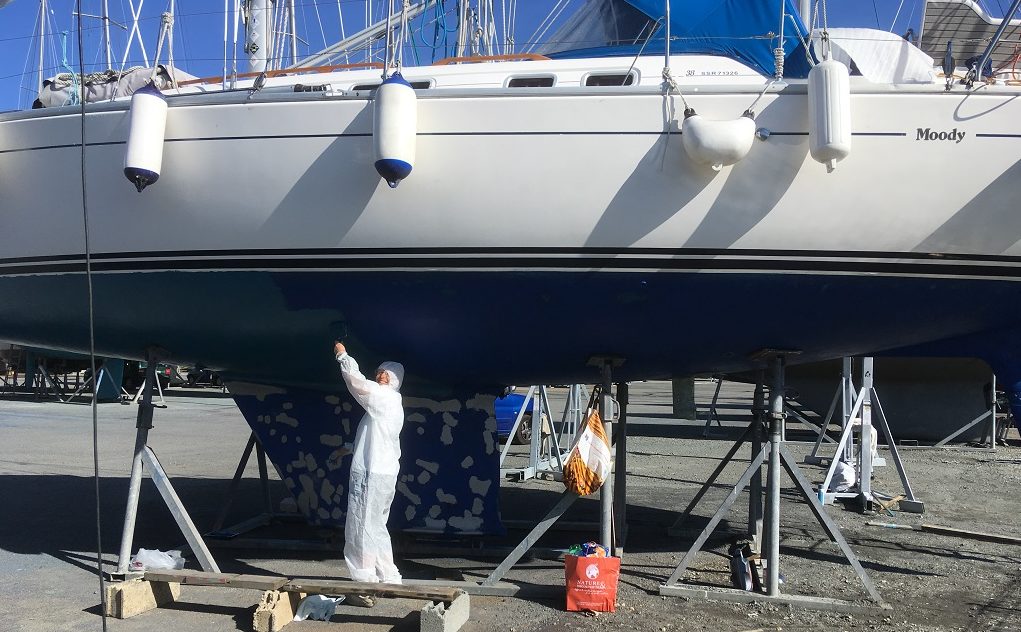
Before we had the boat lifted out of the water at our selected boatyard we dried and removed sails and undertook the first part of the engine service – oil and filter change.
In this part of France the winters can get very cold indeed, and we needed to take care to prepare Calypso for the very cold months ahead. A yacht kept on the hard for the winter will suffer cold weather more than one kept in the water, which effectively partially insulates the boat against extreme cold.
We were lifted into an excellent cradle and undertook the following further works before leaving Calypso for the winter:
- Ran anti-freeze through the raw water part of the cooling system to prevent freezing and inhibit corrosion. We did this by closing the sea-cock and opening the top of the raw water filter – starting the engine and pouring anti-freeze into the filter until it emerged from the exhaust, when the engine was shut down. Some people take a hose off the filter and stick it in a bucket of anti-freeze, but our filter is easily accessible and this method is simple.
- We would have changed the oil in the saildrive, but our impact driver was not where it should have been! This will be done before launch.
- Removed the raw water impeller (with relatively low hours and after careful inspection we will use this again next year before routinely changing it after 2 years).
- Thoroughly exercised all seacocks – we do not grease them as to our mind this would attract grit to stick to the ball valve. We regularly exercise the seacocks through the year and have had no stiff cocks to date (ooh-errr missus!!)
- Removed and cleaned the propeller – from being covered in a lime scale and a disappointing crop of barnacles and tube worm it came up like new – using brick acid, 1200 grit wet and dry followed by a metal polish and the velvet flapwheel on angle grinder treatment. And here it is, looking like new and very pretty (a shame it doesn’t perform as well as it looks):

- Removed other anodes – hull and saildrive, to be replaced next year before launch.
- Power washed, wet scrubbed and antifouled the hull (after treating rust and priming the 3.5 tonne cast iron keel). We would normally do this shortly before launch, however we will be arriving at the start of next year by aeroplane and do not want to have to have to arrive several days before launch to ensure we get (hopefully) a weather window (no rain and the right temperature). We brought from England a can of International Micron Extra 2 as this can be applied up to 9 months before relaunch. With some products the boat has to be launched within 3 months of application. Looking as glamorous as ever, Val did a sterling job whilst Paul did the servicing jobs:

- Removed the 240w (3 x 80w) solar panels and replaced with a single 30w panel. This allowed us to polish up the arch. This also reduces windage. We hope that keeping them in the dark will slow the very gradual efficiency drop that solar panels suffer over many years. The 30w panel will keep the rather expensive new batteries in tip top condition without overcharging them (whilst the MPPT controller should in theory deliver only a low voltage float charge, I am not convinced that there could be a short burst of higher voltage bulk charge every day as the sun rises which is unnecessary and potentially harmful with 240w panels connected).
- Removed and stowed outboard engine, liferaft, horseshoe buoy and danbuoy from the pushpit.
- Removed and carefully rolled and stowed the sprayhood and affixed a tarpauline cover over the companionway and instruments (having removed the chart plotter).
- Emptied the water tanks and drained the calorifier.
- Re-wired a mains electricity cable to enter via the log transducer through-hull and plugged in a small greenhouse tube heater. An unforeseen consequence of the major rewire last winter, with the charger/inverter operating as an uninterrupted power supply, means that the mains battery charger has to be working for the 240v ring main to be live, and we do not want the charger running all winter.
- Removed as much unwanted gubbins into the van as we could – we have carried too much food and too many clothes (as all new cruisers apparently do) and had a good clear-out.
- Moved hanging clothing to grab rails in the saloon (to allow air to circulate around them) and vacuum bagged other clothing and bed sheets, duvets etc..

- General clean around including bilges.
We left Calypso in good shape for the winter, we hope. The boatyard seems very well managed and secure, but we’ll give a review on that next year. We can say that we are saving about £1,000 on our winter berth (inc lift and launch) compared to last year at Hamble point, which we had thought was good value.
We will be visiting an odd time over the winter when we will have a look at 3 other boats of friends who are wintering in the same yard, and they in turn will look over Calypso when they visit. We were not sad to be leaving but very much looking forward to our camping trip to parts of France we have not visited before (more on that shortly) and afterwards to seeing friends and family and to our winter at home.
There are many cruisers who live aboard year round – but that is not for us and we are happy with our 5 months on the boat and 7 months at home split. We have had a great year and are looking forward to Spain 2018.